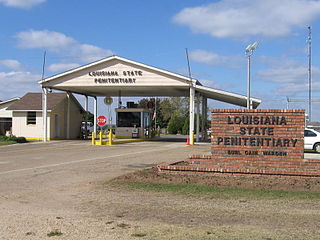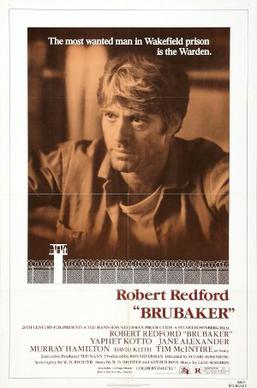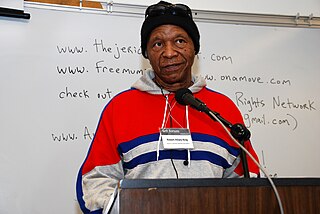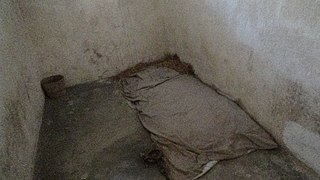
Solitary confinement is a form of imprisonment in which an incarcerated person lives in a single cell with little or no contact with other people. It is a punitive tool used within the prison system to discipline or separate incarcerated individuals who are considered to be security risks to other incarcerated individuals or prison staff, as well as those who violate facility rules or are deemed disruptive. However, it is also used as protective custody on incarcerated individuals whose safety is threatened by others in order to separate them from the general prison population.

Evin Prison is a prison located in the Evin neighborhood of Tehran, Iran. The prison has been the primary site for the housing of Iran's political prisoners since 1972, before and after the Islamic Revolution, in a purpose-built wing nicknamed "Evin University" due to the number of students and intellectuals housed there. Evin Prison has been accused of committing "serious human rights abuses" against its political dissidents and critics of the government.

Pelican Bay State Prison (PBSP) is a supermax prison facility in Crescent City, California. The 275-acre (111 ha) prison takes its name from a shallow bay on the Pacific coast, about 2 mi (3.2 km) to the west.

The Louisiana State Penitentiary is a maximum-security prison farm in Louisiana operated by the Louisiana Department of Public Safety & Corrections. It is named "Angola" after the former slave plantation that occupied this territory. The plantation was named after the country of Angola from which many slaves originated before arriving in Louisiana.

Brubaker is a 1980 American prison drama film directed by Stuart Rosenberg. It stars Robert Redford as a newly arrived prison warden, Henry Brubaker, who attempts to clean up a corrupt and violent penal system. The screenplay by W. D. Richter is a fictionalized version of the 1969 book, Accomplices to the Crime: The Arkansas Prison Scandal by Tom Murton and Joe Hyams, detailing Murton's uncovering of the 1967 prison scandal.

Malik Rahim is an American housing and prison activist based since the late 1990s in the New Orleans area of Louisiana, where he grew up. In 2005 Rahim gained national publicity as a community organizer in New Orleans in 2005 to combat the widespread destruction in the aftermath of Hurricane Katrina; there he co-founded the Common Ground Collective.

The Angola Three are three African-American former prison inmates who were held for decades in solitary confinement while imprisoned at Louisiana State Penitentiary. The latter two were indicted in April 1972 for the killing of a prison corrections officer; they were convicted in January 1974. Wallace and Woodfox served more than 40 years each in solitary, the "longest period of solitary confinement in American prison history".

The Old Idaho Penitentiary State Historic Site was a functional prison from 1872 to 1973 in the western United States, east of Boise, Idaho. The first building, also known as the Territorial Prison, was constructed in the Territory of Idaho in 1870; the territory was seven years old when the prison was built, a full two decades before statehood.

Nathan Burl Cain is the commissioner of the Mississippi Department of Corrections and the former warden at the Louisiana State Penitentiary at Angola in West Feliciana Parish, north of Baton Rouge, Louisiana. He worked there for twenty-one years, from January 1995 until his resignation in 2016.
Herman Wallace may refer to:

Kresty prison, officially Investigative Isolator No. 1 of the Administration of the Federal Service for the Execution of Punishments for the city of Saint Petersburg, was a detention center in Saint Petersburg, Russia. The prison consists of two cross-shaped buildings and the Orthodox Church of St. Alexander Nevsky. The prison has 960 cells and was originally designed for 1,150 detainees.
According to the Louisiana Uniform Crime reporting program, there were 177,710 crimes reported in the U.S. state of Louisiana in 2018. 2018 had the least amount of non-violent criminal offenses since at least 2008. Violent crime decreased from 2017 to 2018, but 2012 still remains the lowest with its record of 22,868. Rape went up 12.7% from 2017 while murder/non-negligent manslaughter declined 7.8%. Additionally, robbery dropped 15% and aggravated assault dropped 1.5%. Handguns remain the leading murder weapon with a rate of 44.7% with firearm following close behind at 35.7%. Together, these two contribute for 80.4% of the murders. Similarly, robberies were committed mostly with firearms in 2018. Firearms were leading with 52% and strongarm listed with a percentage of 35%.

Elayn Hunt Correctional Center (EHCC) located in St. Gabriel, Louisiana, is a multi-security- level Louisiana Department of Public Safety and Corrections institution for adult men. It is the second-largest prison in Louisiana and is located about 70 miles northwest of New Orleans. Elayn Hunt has about half the number of prisoners held at the larger Louisiana State Penitentiary, known as Angola.

Robert Hillary King, also known as Robert King Wilkerson, is an American known as one of the Angola Three, former prisoners who were held at Louisiana State Penitentiary in solitary confinement for decades after being convicted in 1973 of prison murders.
Solitary Watch is a web-based project that aims to bring public attention to the widespread use of solitary confinement in the United States. Its mission is to provide the public—as well as practicing attorneys, legal scholars, law enforcement, and people in prison and their families—with a reputable source of unfolding news, original reporting, firsthand accounts, and research on solitary confinement and other harsh prison conditions to generate public debate and policy change.

The 2013 California prisoner hunger strike started on July 8, 2013, involving over 29,000 inmates in protest of the state's use of solitary confinement practices and ended on September 5, 2013. The hunger strike was organized by inmates in long term solitary in the Security Housing Unit (SHU) at Pelican Bay State Prison in protest of inmates housed there that were in solitary confinement indefinitely for having ties to gangs. Another hunger strike that added to the movement started the week before in High Desert State Prison. The focus of the High Desert State Prison hunger strike was to demand cleaner facilities, better food and better access to the library.

In the United States penal system, upwards of 20 percent of state and federal prison inmates and 18 percent of local jail inmates are kept in solitary confinement or another form of restrictive housing at some point during their imprisonment. Solitary confinement (sometimes euphemistically called protective custody, punitive segregation (PSEG) or room restriction) generally comes in one of two forms: "disciplinary segregation," in which inmates are temporarily placed in solitary confinement as punishment for rule-breaking; and "administrative segregation," in which prisoners deemed to be a risk to the safety of other inmates, prison staff, or to themselves are placed in solitary confinement for extended periods of time, often months or years.
Laurie Jo Reynolds is an American artist most known for her work in policy and social practice. She is a current Assistant Professor of Social Justice at the School of Art and Art History at the University of Illinois at Chicago. She was awarded a Blade of Grass Fellowship for Socially Engaged Art in 2014, a Creative Capital award for Emerging Fields in 2013, and a Creative Time Annenberg Prize in 2013. Working in what she calls "legislative art," her work primarily manifests outside the gallery or museum, though she has been included in exhibitions at the Santa Monica Museum, and the Van Abbemuseum.
Criminal justice reform seeks to address structural issues in criminal justice systems such as racial profiling, police brutality, overcriminalization, mass incarceration, and recidivism. Criminal justice reform can take place at any point where the criminal justice system intervenes in citizens’ lives, including lawmaking, policing, and sentencing.
Herman's House is a documentary film, directed by Angad Singh Bhalla and released in 2012. An American, British and Canadian coproduction, the film profiles Herman Wallace, a member of the Angola Three who had been in prison for over 40 years after his shorter prison term for bank robbery was extended with a disputed conviction for a murder he did not commit, and Jackie Sumell, a conceptual artist who has launched a project of building the dream house Wallace wishes he could live in if he is ever released from prison.














